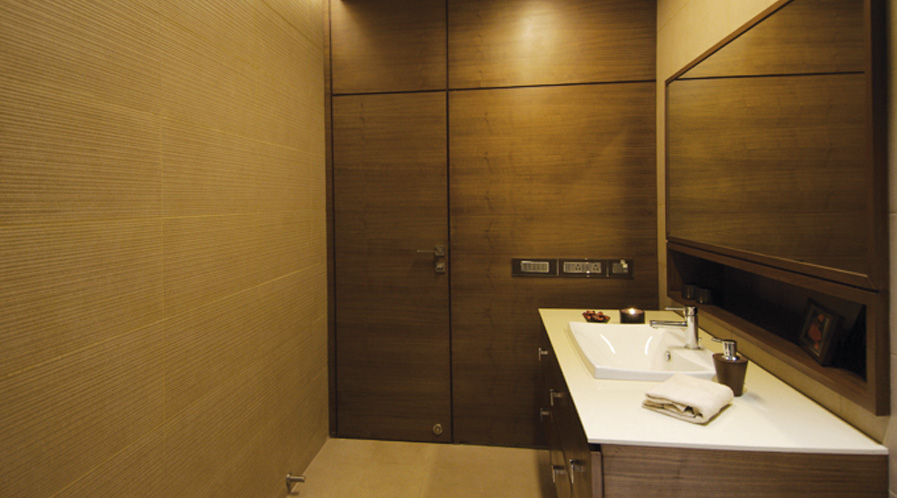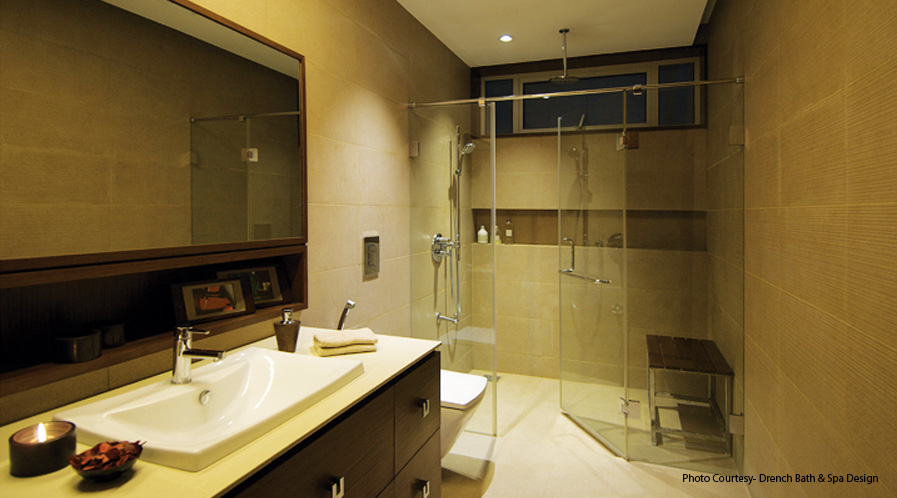Washroom Design For the Elderly
While safety and convenience are the key words for washrooms for use by senior citizens, they do not have to appear clinical or dull according to Megha Dave Srinivasamurthy.
Although relax, unwind and contemplate are some of the emotions generally evoked by luxury bathrooms, to some, the very space can evoke feelings of imbalance, uncertainty and fear. As users grow from mid-life senior to elderly, one of the most important space of concern is the washroom. Around 80% of the falls in a home occur in washrooms. Anyone can stumble and fall but having poor muscle strength and balance as a person ages is associated with increased risk.
Chances are, picturing a mobility friendly bathroom, often means envisioning a whole host of unsightly grab bars and other less than aesthetically pleasing equipment, but with developments in design and careful planning that doesn’t have to be the case.
Here we speak of some subtle bathroom design elements that will help increase safety and mobility. Featured washroom is designed for the use of an elderly but mobile couple with planning that respects and encourages independent carefree use but also has subtle elements, the use of which will emerge in an event of assisted living. Following elements have been added in the featured washroom to increase safety without compromising design and aesthetics.
Space to move-
While designing a bathroom for long term use, the most important thing to be borne in mind is that space will be a greater issue as people age. Thus planning for the use of canes, wheelchairs, walkers or similar assistive devices is a good idea. As in the washroom featured here, all the plumbing elements are well spaced out and in a single row so as to allow maximum barrier free circulation space.
Slip resistant flooring
This may seem incredibly obvious, but the washroom should be free of slippery walking surfaces. In this example, we have used anti- skid tile for the entire flooring and shower area. Since the texture and colour is the same as the other wall tiles, the appearance is very subtle and can be discerned only on closer look. For existing flooring, anti -skid coating can be applied on marble or tiles to attain grip.
Toilets
Having the toilet at the proper height can make an incredible difference in the comfort and safety of the washroom. The toilet is hung on a frame that features adjustable feet – designed primarily to cope with uneven floor surfaces that can also be used to elevate the height of the toilet bowl to a more comfortable height of 46cm from the floor. The right WC needs to be selected for the people who will be using it and the height should be properly adjusted.

Shower Mixers
With age the skin becomes thinner and the risk of scalding increases. Use of thermostatic shower mixers ensures that the temperature of the shower water remains constant for the duration of the bath, regardless of any fluctuations in the water supply. A Safe Stop button prevents the temperature from accidentally being raised above 38º Celsius. Latest technology ensures that the surface temperature of these thermostats and the handles of hand showers is never higher than that of the mixed water. Concealed thermostatic shower mixers allow for the flexibility to install the mixer at a comfortable height and in a convenient location.
Shower heads
An adjustable shower head (which moves to suit the height and position most comfortable for a user) is a great way to add accessibility to a washroom. Here, the hand shower on rail creates an even more functional experience. Ceiling mounted shower is provided so the elderly can have a comfortable bathing experience independently or in case of assisted use. This is very convenient for care giver as well as the user. Using these two in conjunction with a shower seat will make it much easier to bathe.
Shower Seats
Adding a shower seat can relieve the strain experienced with standing for extended periods of time. These seats allow a person to safely shower and check the chance of falling. There are many types of shower seats to choose from, a few being shower stools, shower chairs, retractable (or fold-up) seats as well as, built-in seats. In this washroom, there is a stool that can be conveniently moved to below the rain shower.
Curb less shower enclosures
Installation of shower enclosures is a very important step in keeping rest of the bathroom dry, therefore, safe. For the seniors that can’t lift their legs, putting in a curbless shower can be a lifesaver. A curbless shower enclosure can make the transition from wheelchair/ walker to shower seat simple and easy for the senior and the caregiver.
Lighting
Another important feature that is worth taking note of is the layered lighting. By simply improving visibility, chances of tripping and falling can be decreased considerably. This washroom presents an example of how colour choices and lighting can combine to increase safety. The cove light acts as a night light which gives soft ambient light providing enough visibility without sudden glare in the night time. There is added focused light over the WC, shower and basin areas which can be switched on when required. This not only makes the space more aesthetic but also gives focused task lighting where required. Even simple changes can make a big difference when it comes to improving safety.

Megha Dave Srinivasamurthy
Principal Architect and Design Head, Drench bath & spa design and Style Box
“Washrooms for the elderly do not have to look staid and clinical. They simply have to provide support and safety which can be easily incorporated with careful and sensitivity to the needs of senior citizens.”
Counter Space
It is essential to ensure there is plenty of counter space. Not only does this help to cut down on the clutter, it also will prepare the area for future space needs in caring for someone. Installing a contrasting colour on counter top will help anyone who has diminishing eyesight and/or balance issues feel more at ease and help reduce accidents. Subtle levelling on edges of the counter-top ensure that there are no sharp edges and helps curb cuts and bruises should someone fall against it.
Niches
Niches are provided in shower and basin areas instead of protruding shelves. This adds accessibility and decreases risk of injuries should there is a fall against it.
Grab bars and other aides.
Choice of using grab bars depends upon on the level of mobility of the person using the washroom. Typically, the term ‘grab bars’ invokes imageries of something that looks like it belongs in a hospital (cold and metal). Today, grab bars come in a variety of styles and colours to match decor and taste.
Installing bracing in walls around the shower, shower seat or WC even if there is no immediate plan on installing grab bars, can make the washroom future proof to some extent. This will make the walls prepared to support the grab bars when they are required to be added and save on additional renovation works later.
Rugs and floor mats.
It should be no surprise that throw rugs are a major cause of tripping and falling in the home. If one must have rugs in the bathroom, a rug with a low pile, secured with anti-slip rug tape is a better option. However, for an elderly user’s washroom it is recommended that rugs are removed from the bathroom entirely. To conclude, washrooms for the elderly do not have to look staid and clinical. They simply have to provide support and safety which can be easily incorporated with careful and sensitivity to the needs of senior citizens.
Tags: Concealed Thermostatic Shower, Counter Space, Curb less Shower Enclosures, Grab Bars, Lighting, Luxury Washroom, Shower Heads, Shower Mixers, Shower Seats, Slip Resistant Flooring, Thermostatic Shower Mixers, Toilets, Washrooms for the elderly



